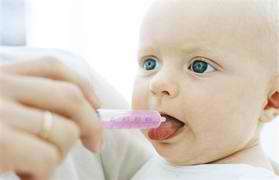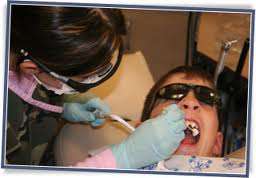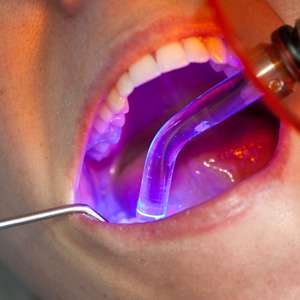dental

pertaining to the teeth.
dental assistant a specially trained health care worker who provides direct support to the dentist. An educationally qualified dental assistant may be delegated to do intraoral procedures that do not require the professional skill and judgment of a dentist. Although not all states require formal education for dental assistants, minimum educational standards include a program of approximately one academic year. Dental assistants may take the Certification Examination administered by the Dental Assisting National Board and earn the title of a Certified Dental Assistant (CDA). Some state boards of dentistry register dental assistants (RDA) after completion of a state-administered examination. Dental assistants may be members of their professional organization, the American Dental Assistants Association (ADAA), whose address is American Dental Assistants Association, 203 N. LaSalle St., Chicago, IL 60601.
dental caries a process of demineralization of tooth enamel, leading to destruction of enamel and dentin, with cavitation of the tooth. Decayed and infected teeth can be the source of other infections throughout the body, and decayed or missing teeth can interfere with proper chewing of food, leading to nutritional deficiencies or disorders of digestion. Called also tooth decay.
Causes. The causes are not completely understood, but certain facts are known. Tooth decay seems to be a disease of civilization, possibly associated with refined foods. Lack of dental cleanliness is also closely associated. Decay occurs where food and bacteria such as Lactobacillus species and Streptococcus mutans adhere to the surface of the teeth, especially in pits or crevices, and form dental plaque. It is believed that the action of the bacteria on sugars and starches creates lactic acid, which can quickly and permanently dissolve tooth enamel. The acid produced in just 20 minutes after sugar comes into contact with plaque is enough to begin this process. In most people this occurs whenever sweet foods are eaten; thus, eating of sweet or starchy foods between meals or at bedtime can be harmful to the teeth unless they are thoroughly brushed and rinsed immediately afterward. Decay that is not treated will progress through the enamel and dentin into the pulp, which contains the nerves. When it reaches the pulp, it can cause intense pain. There is no relief until the pulp dies or is removed or the tooth is extracted.
Treatment. The treatment for tooth decay consists of elimination of the pathogenic microorganisms that cause it, along with regular dental care. Enamel that has been destroyed does not grow back. The decay must be removed and the cavity filled. fillings (or restorations) may be of gold foil, baked porcelain, synthetic cements, silver amalgam, or cast gold inlays. When decay has reached the pulp, formerly extraction was usually necessary. Whenever possible, however, the exposed pulp is re-covered, or capped, and the tooth is then filled. New techniques of root canal therapy are saving many teeth that would formerly have been lost.
Prevention.
Flossing and Brushing the Teeth. Cleanliness is the best weapon against caries and periodontitis. Bacteria and food particles must be removed before the enamel is penetrated. This means thorough brushing regularly each day, preferably after every meal. If it is impossible to brush after every meal, it is helpful to rinse the mouth by swishing water vigorously back and forth between and around the teeth. When the teeth are brushed, food particles that lodge between the teeth should also be removed with dental floss.
The dental floss should be strung tightly between the two index fingers or between the bows of a floss holder. Flossing and brushing should be done in an orderly sequence so that no area is neglected. The usual pattern is beginning at the upper right, progressing to the upper left, and then from the lower left to the lower right. The floss is gently inserted between the teeth and pulled against the surface of one tooth to a point slightly under the tissue of the gum. It is then moved up and down for several strokes. The adjacent tooth is cleaned in the same manner.
The “sulcular” technique for brushing the teeth is so called because the bristles of the brush are worked beneath the free gingival margin and into the space between the tooth and the gum (the sulcus). To accomplish this the bristles are placed at a 45 degree angle to the gum line. Pressure is then used to move the brush back and forth in a circular motion. The brushing is continued around the mouth in the same pattern as the flossing.
A disclosing dye may be used to determine the presence of plaque on the teeth. Flavored mouthwash does not reduce plaque formation and is useful only to moisturize the tissues and improve mouth taste. (See also mouth care.)
Proper Diet. In order to help maintain healthy teeth, the diet should include all the essential elements of good nutrition. Tooth decay can be reduced by limiting the intake of certain forms of sugar, especially the rich or highly concentrated ones such as in candy or rich desserts.
fluoridation is another important means of preventing caries. Many communities whose water is lacking in an adequate natural supply of fluoride add the chemical to their water supply. In communities that do not have fluoridation, dental professionals may add a fluoride solution directly to the teeth or may suggest other means of obtaining fluoride protection.
Correction of Malocclusion. Another factor leading to tooth decay is malocclusion (poor position of the teeth), which results in faulty closure of the jaws and uneven meeting of the teeth. This should be corrected early because it also can lead to inadequate nutrition because of difficulty in chewing, and if it is severe enough to distort the face, it may have psychologic effects.
Miller-Keane Encyclopedia and Dictionary of Medicine, Nursing, and Allied Health, Seventh Edition. © 2003 by Saunders, an imprint of Elsevier, Inc. All rights reserved.
thefreedictionary.com/






